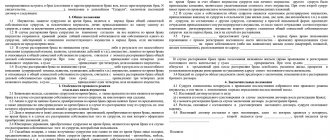Agreement on termination of shared ownership. Property in shared ownership may be divided between its participants by agreement between them.
A participant in shared ownership has the right to demand the allocation of his share from the common property.
If the participants in shared ownership fail to reach an agreement on the method and conditions for dividing the common property or the allocation of the share of one of them, the participant in shared ownership has the right to legally demand the allocation in kind of his share from the common property. If the allocation of a share in kind is not permitted by law or is impossible without disproportionate damage to property in common ownership, the allocated owner has the right to have the value of his share paid to him by other participants in shared ownership. The disproportion between the property allocated in kind to a participant in shared ownership on the basis of this article and his share in the right of ownership shall be eliminated by payment of an appropriate sum of money or other compensation. Payment of compensation to a participant in shared ownership by the remaining owners instead of allocating his share in kind is permitted with his consent. In cases where the owner’s share is insignificant, cannot be realistically allocated and he does not have a significant interest in the use of the common property, the court may, even in the absence of the consent of this owner, oblige the remaining participants in the shared ownership to pay him compensation.
View other sample agreements...
Common shared ownership of real estate: what is it?
According to (hereinafter referred to as the Civil Code of the Russian Federation), shared ownership is a type of common ownership. That is, it belongs to several citizens in certain shares, the amount of which is reflected in the extract from the Unified State Register of Real Estate. In this case, the shares can be either equal or established in any other ratio.
The right of common shared ownership of real estate may arise under the following conditions:
- purchase of property in shares;
- receiving an object as an inheritance together with other heirs;
- privatization of an apartment or house for several people;
- division of joint property between spouses.
Features of ownership, use and disposal of shared property are reflected in a number of legal acts:
- Civil Code of the Russian Federation. Defines the terms and basis of the legal regime of property in shares.
- reflects the legal features of the rights to part of the apartment.
- The Family Code regulates the procedure for transferring joint property of spouses into shared property.
- (hereinafter referred to as Federal Law No. 218) establishes the rules for registering real estate in Rosreestr.
Another law has been adopted, the subject of which is common shared property -. From July 31, 2019, it abolishes the need for notarization of most transactions with shared property.
Find out more about what common ownership of an apartment and shared ownership of a house are.
When can the right of shared ownership be terminated?
The reasons why an equity right is terminated depend not so much on legislative norms as on actual circumstances.
So, among them we can highlight:
- Alienation of a share by concluding a transaction, including unilateral: purchase and sale, donation, will. In accordance with, owners of shares can freely dispose of them by concluding any gratuitous or compensated transactions. As a result, shared ownership will become individual if one shareholder sells his part of the property to the second.
- Allocation of a share in kind or determination of a separate share in individual property. At the same time, the allocation of property in kind is possible, but only when this does not affect its quality. If the procedure is impossible, the share can be compensated.
- Appeal for share of recovery. The right to take such action belongs to the creditor. Usually he has no interest in such property, so he tries to sell the share to a co-owner. And after the latter agrees to the transaction, shared ownership is terminated.
- Actual loss or destruction of a property share.
Thus, there can be many reasons. The termination procedure also depends on them.
Nuances when redistributing shares
You can change the size of shares in relation to a house, land plot, apartment, while the process itself has some features.
During privatization
According to Art. 245 of the Civil Code of the Russian Federation, the shares of privatization participants are considered equal by default. One of the potential owners may refuse his share, then it will be distributed among the others.
If the parties wish to increase (decrease) the shares of the others and have grounds for this, an agreement can be drawn up on the redistribution of shares. If the remaining participants do not agree to make concessions, they can contribute part of the funds to compensate for the cost of improvements made by one of the co-shareholders.
In a private household
House owners who have agreed on the redistribution of shares in real estate draw up a corresponding agreement.
If there is a need to give someone his share, one of the parties can enter into a purchase and sale transaction or donate part of the real estate belonging to him
At the same time, it is important to remember the right of first refusal of the remaining co-owners in accordance with Art. 250 of the Civil Code of the Russian Federation, that is, the remaining residents must be sent a written notification of the sale and receive a refusal or consent
In the case of a donation (sale), there is a quantitative change in the composition of the co-owners, while the size of the share changes only for one (the seller, the donor).
Land plot
Land owners can agree on the redistribution of land plots (Article 11.7 of the Land Code of the Russian Federation)
It is important to take into account the rules:
- redistribution should not affect the ability of other sharecroppers to access buildings and communications;
- the size of the created plots must correspond to the established standards in the relevant locality.
The parties can change the size of shares by selling their property parts or donating them.
When inheriting
By default, the shares of heirs in the inheritance mass are considered equal. Having received certificates of right to inheritance, successors can enter into a written agreement on the redistribution of shares.
When drawing up an agreement, co-shareholders must be guided by the rules of law. If a document is drawn up incorrectly, is not certified by a notary, or the registration procedure is ignored, the document will not have legal force. To dispose of shares legally, find out in advance: how to correctly draw up an agreement on the redistribution of shares of a house, land, or apartment? What needs to be done for the document to have legal force? A lawyer from the website ros-nasledstvo.ru will provide answers to all questions free of charge.
Buying out a share from a co-owner
According to Part 2 of Art. 246 of the Civil Code of the Russian Federation, the shared owner can dispose of the property at his own discretion, for example, sell. But at the same time, he is obliged to take into account the preemptive right of the second person to purchase. It is established by regulations. To do this, the seller must send a written notice to the co-owner with an offer to buy the share. It indicates the price and other terms of the transaction.
The property can be sold to a third party if the remaining shareholders refuse to purchase or do not respond to the offer within the following deadlines:
- on the purchase of real estate - within 1 month;
- on the acquisition of movable property - within 10 days.
If they are immediately prepared to submit a refusal in writing, the transaction with an outside party can take place on the same day.
Options for redistribution of shares
There are several basic options for redistributing shares:
- Purchase and sale. An obvious and simple option, in which the share is redistributed due to the fact that one party sells part of the property, and the second buys.
- Exchange. A similar option to the previous one, in which one party receives part of the share, and in return transfers something else. For example, a share in another apartment, a car, equipment, and so on.
- Giving. A cheap and simple option, in which you don’t even have to take into account the pre-emptive right of the co-owners. One party simply gives part of its share to the other party.
- Redistribution. And the most common, as well as simplest, option is in which there is a direct redistribution of shares based on the concluded agreement of the parties. Let's consider this system in more detail.
Division of common shared property
Common property, the right to which belongs in shares to several persons, can be divided by agreement between them (). Since such a division is made between all participants, its result is the complete termination of shared ownership. The resulting objects are recognized as independent and subject to processing independently of each other.
If the division of common shared property occurs by common consent, it is formalized by an agreement. If one of the parties has objections - in court if there are sufficient grounds.
How to enter into a separation agreement
Division by concluding an agreement assumes that all participants have managed to agree and therefore want to terminate shared ownership voluntarily. It should be noted that it is possible to divide only that property that lends itself to it without loss of properties for its further autonomous use.
Although there is no standardized form of document, the agreement on termination of shared ownership must contain the following information:
- passport details of all co-owners;
- information on the size of shares at the time of conclusion of the transaction;
- description of the object, all characteristics and details of title documents;
- characteristics of the result of the division: description of the shares and the property that should be formed as a result;
- establishing the amount of compensation to any of the participants, if any is expected;
- distribution of costs associated with the execution of the agreement: payment for real estate reconstruction, legal services;
- consequences of execution of the agreement in the form of termination of shared ownership;
- date and signatures of the parties.
In relation to real estate, the termination of the right of common shared ownership by agreement of the co-owners ends with the formation of independent objects of civil rights of the same type as the original one. For example, instead of one house, two are formed. But each of them will have its own characteristics that differ from the original structure: a different address, area, etc. The original object will cease to exist.
How to divide property in court
If the parties fail to reach an agreement, the division is carried out in court. To do this, you should draw up a statement of claim demanding the division and termination of common shared ownership. If the issue concerns real estate, the claim is filed at its location.
The document must contain the following information:
- Full name of the plaintiff;
- the essence of his requirements, indicating information about the object to be divided,
- the basis for the transfer of ownership rights to it;
- information about co-owners;
- explanation of the need for the section;
- a description of the measures taken by the plaintiff to resolve the dispute peacefully.
Title documents and other evidence should be attached to the claim.
Then the registration of part of the house or apartment after the trial occurs in the standard manner - by registering the object in Rosreestr.
How to draw up an agreement correctly
Contractual relations between the parties are regulated by the articles of Chapter. 28-29 Civil Code of the Russian Federation. According to Art. 421 of the Civil Code of the Russian Federation, shareholders are given freedom of choice. If one of the parties disagrees with the proposed distribution of shares, the issue is resolved in court. You cannot be forced to enter into an agreement.
The agreement on the determination of shares is concluded in writing and is subject to notarization for subsequent smooth registration with Rosreestr.
The legality of the procedure depends on compliance with the rules for drawing up the document, compliance of its form and content with current legislation.
Form
The written agreement must bear the signatures of all shareholders as evidence of agreement with the stated division of the plot.
The structure of the document is as follows:
- title of the document “Agreement on the determination (change, redistribution) of shares in a land plot in the right of common ownership”;
- place of document preparation (city);
- date of execution of the agreement;
- information about the parties to the agreement: full name (if changing surname, indicate the old one), passport details;
- information about the land plot indicated in the cadastral passport;
- information about documents on the basis of which shareholders are owners of shared property;
- information about possible encumbrances on property, seizure, easement;
- indication of the size of the shares of each of the co-owners;
- confirmation of the consent of all participants to the allocated sizes of shares;
- rights and obligations of shareholders;
- information about cost sharing;
- confirmation that the agreement is signed voluntarily, without external pressure, and all participants are aware of their actions;
- number of copies (there should be several of them - for each of the parties, the notary and for presentation to Rosreestr);
- date of registration and signature of the parties.
Agreement form
To draw up a document yourself, you can use a standard form, inserting personal data and information from title documents into it:
agreements on determining shares in a land plot
Required documents
When drawing up a contract, you must have a package of documents:
- passport;
- title documents for land (agreement, certificate of inheritance or others);
- cadastral passport, extract from the Unified State Register;
- receipt of payment of state duty.
After completing the agreement, you must contact the Rosreestr office or the MFC, since government agencies must record the redistribution of land shares between owners.
Costs of drawing up an agreement
If the plot of land is properly registered and has a cadastral passport, there will be no need to carry out work to demarcate the plot. If there are no documents, you will have to contact a geodetic organization that has a license to carry out demarcation work. Depending on the complexity of the terrain, costs can vary between 2-20 thousand rubles.
Read more: How to survey a land plot in shared ownership
You will have to pay a state fee directly to certify the agreement.
Calculation example. The plot is located in the Ryazan region and belongs to 4 owners. They decided that one of them would get ½ of the plot, and the rest would get 1/6. The price of the plot, according to the Unified State Register of Real Estate, amounted to 680 thousand rubles. According to the law, the state duty is 0.5% of the amount, which amounted to 3,400 rubles. Owners pay part of the state duty in proportion to their share: the owner of ½ of the plot - 1,700 rubles, and the rest - 566.67 rubles.
Additional costs will be associated with applying to Rosreestr. According to clause 1.25, clause 1.26 of Art. 333.33 of the Tax Code of the Russian Federation, state registration of rights to a land plot will amount to 350 rubles, and when making an entry in the Unified State Register of Real Estate about the share in the right of common ownership of agricultural land, the state duty is 100 rubles.
If a notary facilitates the conclusion of an agreement: coordinates the process of preparing documents, helps to correctly present information, shareholders pay for the legal and technical services provided. Their cost is not a fixed value, so you should check the price in advance. On average, costs will be about 5 thousand rubles.
Determining shares in land is not a complicated process, but only if you know the regulations governing the procedure for drawing up an agreement. By acting alone, you can make mistakes in which the agreement will be invalid, and fixation of shares in Rosreestr will be impossible.
Don’t know why an agreement to determine a land share is concluded, how to draw up an agreement correctly, what documents are required for the agreement and where to get them? Contact a lawyer from the website ros-nasledstvo.ru for a free consultation.
USEFUL INFORMATION: Selling an apartment purchased using maternity capital
Allocation of share in kind
According to, a share in kind can be allocated from the common property. In this case, the original property actually becomes smaller in volume. But the share right does not terminate for all participants (if there are more than two), but only for the owner of the new object.
It is not always possible to highlight the natural part in proportion. Conditional “injustice,” according to , is eliminated through monetary or other compensation, for example, the transfer of other property.
Sometimes selection in kind is physically impossible. Thus, it is impossible to select a part of the car. This also applies to real estate. As follows from Federal Law No. 218, at present, registration of real estate as a result of the allocation of a share in kind is carried out only in relation to land plots. If we are talking about buildings and structures, only division is possible.
If the allocation is permitted in theory and feasible in practice, you can enter into an agreement or go to court for an appropriate decision.
More about how a share in a private house is allocated in kind.
How to correctly fill out an agreement on the procedure for using common property
There are no legally approved templates or agreement forms. The only legal act that stipulates the use of joint property is Article 247 of the Civil Code of the Russian Federation, which states the following provisions:
- Owners of any property that is in shared ownership are obliged to use it by agreement of all co-owners; if an agreement is not reached, then by court decision.
- Any co-owner has the right to have a part of the residential premises for his possession and personal use commensurate with his part of the property. If the fulfillment of this right is impossible for technical or any other reasons, he may demand from other co-owners who actually use part of his share of the property, appropriate monetary or other compensation.
In essence, the agreement is a document in which the signatories establish for each of the co-owners his personal space (a separate room or part of it), as well as the procedure for using common property (bathroom, pantry, kitchen, other common areas).
The costs of maintaining a joint living space are borne by each of the owners, in proportion to his share of ownership (Article 249 of the Civil Code of the Russian Federation). Maintenance costs include:
- communal payments;
- taxes;
- capital repair fee;
- expenses for cosmetic repairs in common areas;
- expenses for maintenance of common areas.
For example, two brothers live in a two-room apartment, owning it in shares, while the older one has a share of two-thirds of the apartment and occupies a large room, the younger one owns one-third of the living space and lives in a small room. Utility bills amount to three thousand a month, in addition, the brothers renovated the kitchen, paying 60 thousand rubles for the repair.
Since the older brother owns two-thirds of the living space, his utility bills will be two thousand rubles a month, the younger brother must pay one thousand rubles. For the renovation of the kitchen, the elder must contribute 40 thousand rubles, and the younger brother - half as much, only twenty thousand.
Features of termination of shared ownership of an apartment
Dividing an apartment into shares is not the easiest thing. In order to produce it, certain conditions must be met:
- compliance of the separated premises with sanitary and technical standards, as well as the established minimum living space per person;
- each resulting object has its own entrance;
- the ability to allocate a kitchen and bathroom for each of them.
If all the above requirements cannot be met, division of property is not allowed. However, there is an alternative option for transforming it into an individual one - buying out a share from its participant.
Find out in more detail how to sell an apartment in shared ownership.
Subtleties of terminating shared ownership of a house and land
The general share right to a land plot is the only share right to real estate, which allows you to both divide the object and allocate part of it in kind. However, the process becomes significantly more complicated if an individual residential building is erected on the land plot, since the land and the house have a single legal destiny. This means that the plot cannot be divided without dividing the house.
In order to figure out how to terminate the right of shared ownership of a residential building, the first step is to check whether the rules in relation to the resulting objects will be observed:
- a separate entrance is provided;
- separate engineering communications, heating and cooking appliances, a kitchen and a bathroom are organized;
- facilities meet sanitary and housing standards;
- houses can be assigned addresses.
If all of the above points are feasible, shared ownership can be divided by concluding an agreement on the division of a residential building or through the court. After this, the newly formed objects should be registered with Rosreestr.
Learn more about what common shared ownership of a land plot means.
How the right of joint ownership is terminated
By law, the property of the spouses is joint, unless otherwise specified in the marriage contract. In accordance with, the division of joint property can be carried out in court or on the basis of an agreement concluded between the spouses. Such a document can be signed before or after the divorce. It must be formalized in written notarial form, otherwise it will not entail any legal consequences.
There are no rules for dividing property by agreement. Spouses can distribute property among themselves as they see fit.
If the termination of the right to common joint property could not be arranged peacefully, the spouses have the right to file a corresponding claim in court. After a court decision has entered into legal force or an agreement has been signed, you can go to Rosreestr for re-registration of property.
It should be noted that the property of a husband and wife can be acquired in shares, subject to an appropriate agreement. In this case, the shared ownership of the spouses is terminated in the standard manner.









